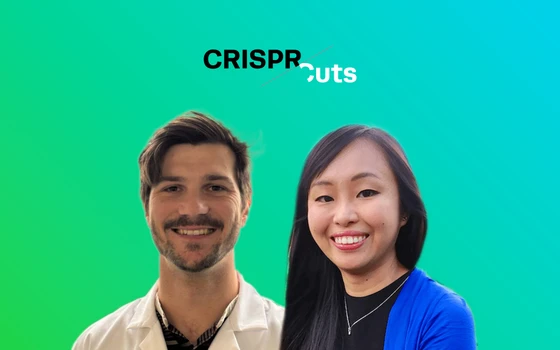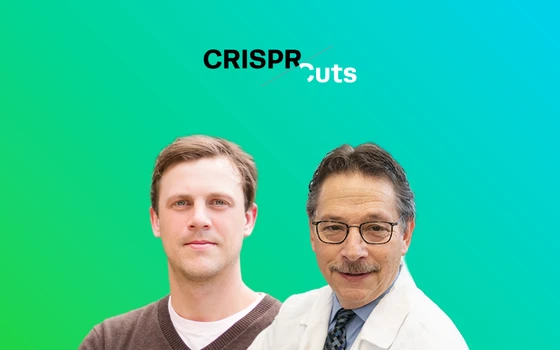RNP: An Efficient Alternative to CRISPR Plasmids
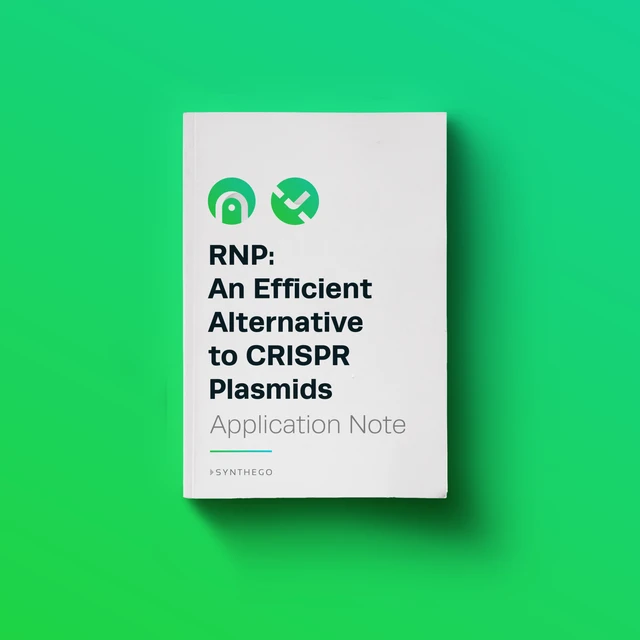
The applications of CRISPR in disease research are well known but this tool is making a huge impact in agriculture as well. We recently interviewed Dr. Jessica Lyons and Dr. Michael Gomez about their cassava food safety project. Jessica is a staff scientist at UC Berkeley and the Innovative Genomics Institute and the PI of the project, and Michael is a postdoctoral scholar at IGI also working on this study.
Cassava is commonly consumed in many tropical countries, although it may be named differently per region. Michael grew up knowing it as “yuca” in his Colombian family, while in the States it’s famous as tapioca (pearls in Boba tea). The roots of cassava naturally contain a precursor of cyanide, which can be removed by proper processing, and ensuring a protein-rich diet helps break down the cyanide. However, when improperly processed cassava is consumed with a low-protein diet, the chronic cyanide consumption can result in deleterious neurological impairment. In severe cases, it could result in konzo disease, symptomized by paralysis.
As cassava is a staple food source for about 40% of Africans, the issues associated with chronic cyanide poisoning are disproportionately seen in Africa, primarily among those eating a monotonous diet of cassava.
In this blog post, we cover how Jessica and Michael are using CRISPR to mitigate the food safety issues associated with cassava. Curious to learn more about their project? Tune into the podcast or read on for a summary.
Project Overview: CRISPR Reduces Cyanide in Cassava
In the first section, we talk about the project basics: motivation behind the project, importance of CRISPR in ensuring food safety, and possible ways of confirming experimental success.
Cassava: a staple crop in the tropicsMinu: Could you give a quick overview on what exactly you do and how you're using CRISPR in cassava?
Jessica: Cassava is a really important staple crop for people who live in the tropics around the world, and about a billion people in the world, including about 400 million Africans, rely on it as a staple. It has these starchy tuberous roots that are a great source of calories. So cassava is really an important crop, and one issue with it though is that the roots contain a precursor of cyanide. When the root is consumed, the cyanide can be released in the body.
Now when the cassava is properly processed, the cyanide is removed. But there are a lot of reasons that this might not be done properly. The processing could involve something like soaking for a few days. So if you're starving, then that might not be an option for you. The processing also falls disproportionately on women, and it's a lot of work. So the impetus of our project is to really mitigate those neurotoxic effects of accidental and/or chronic ingestion of the cyanide and also the work that it requires to process it.
Minu: Could you give a quick overview on what exactly you do and how you're using CRISPR in cassava?
Jessica: Cassava is a really important staple crop for people who live in the tropics around the world, and about a billion people in the world, including about 400 million Africans, rely on it as a staple. It has these starchy tuberous roots that are a great source of calories. So cassava is really an important crop, and one issue with it though is that the roots contain a precursor of cyanide. When the root is consumed, the cyanide can be released in the body.
Now when the cassava is properly processed, the cyanide is removed. But there are a lot of reasons that this might not be done properly. The processing could involve something like soaking for a few days. So if you're starving, then that might not be an option for you. The processing also falls disproportionately on women, and it's a lot of work. So the impetus of our project is to really mitigate those neurotoxic effects of accidental and/or chronic ingestion of the cyanide and also the work that it requires to process it.
Editing cassava genes using CRISPRMinu: How did you come across CRISPR as the right tech to use in this project?
Jessica: I've been working on cassava since 2012 and yams since 2015 or so. I'm really interested in using modern genetic approaches to facilitate the improvement of African crops. As CRISPR became more of a thing and more of an option for cassava, that was sort of my segue into collaborating with Michael and his PI Brian on using CRISPR in cassava.
Michael: I entered grad school in 2012 with a really strong interest in diseases, how they work, how the interplay is with the host. That was the time when CRISPR emerged. And it has been a roller coaster seeing how this technology has been applied. It's been a lot of fun! I'm excited to apply it for consumer safety with our cassava project.
Minu: How did you come across CRISPR as the right tech to use in this project?
Jessica: I've been working on cassava since 2012 and yams since 2015 or so. I'm really interested in using modern genetic approaches to facilitate the improvement of African crops. As CRISPR became more of a thing and more of an option for cassava, that was sort of my segue into collaborating with Michael and his PI Brian on using CRISPR in cassava.
Michael: I entered grad school in 2012 with a really strong interest in diseases, how they work, how the interplay is with the host. That was the time when CRISPR emerged. And it has been a roller coaster seeing how this technology has been applied. It's been a lot of fun! I'm excited to apply it for consumer safety with our cassava project.
Assays for determining successMinu: How would you test the success of your experiments?
Jessica: We can measure the cyanide in the roots. In our greenhouse we have little baby plants that get up to a few feet tall. These mini plants have tuberous roots, and we use a kit that was actually developed by Australia National University for use in Africa to measure the cyanide levels in the tissue. We measure it in leaves and roots because cyanide is made in the leaves. So we take some leaf tissue or some root tissue, and we put it in a vial with some buffer and paper that turns color when it detects cyanide.
Minu: How would you test the success of your experiments?
Jessica: We can measure the cyanide in the roots. In our greenhouse we have little baby plants that get up to a few feet tall. These mini plants have tuberous roots, and we use a kit that was actually developed by Australia National University for use in Africa to measure the cyanide levels in the tissue. We measure it in leaves and roots because cyanide is made in the leaves. So we take some leaf tissue or some root tissue, and we put it in a vial with some buffer and paper that turns color when it detects cyanide.
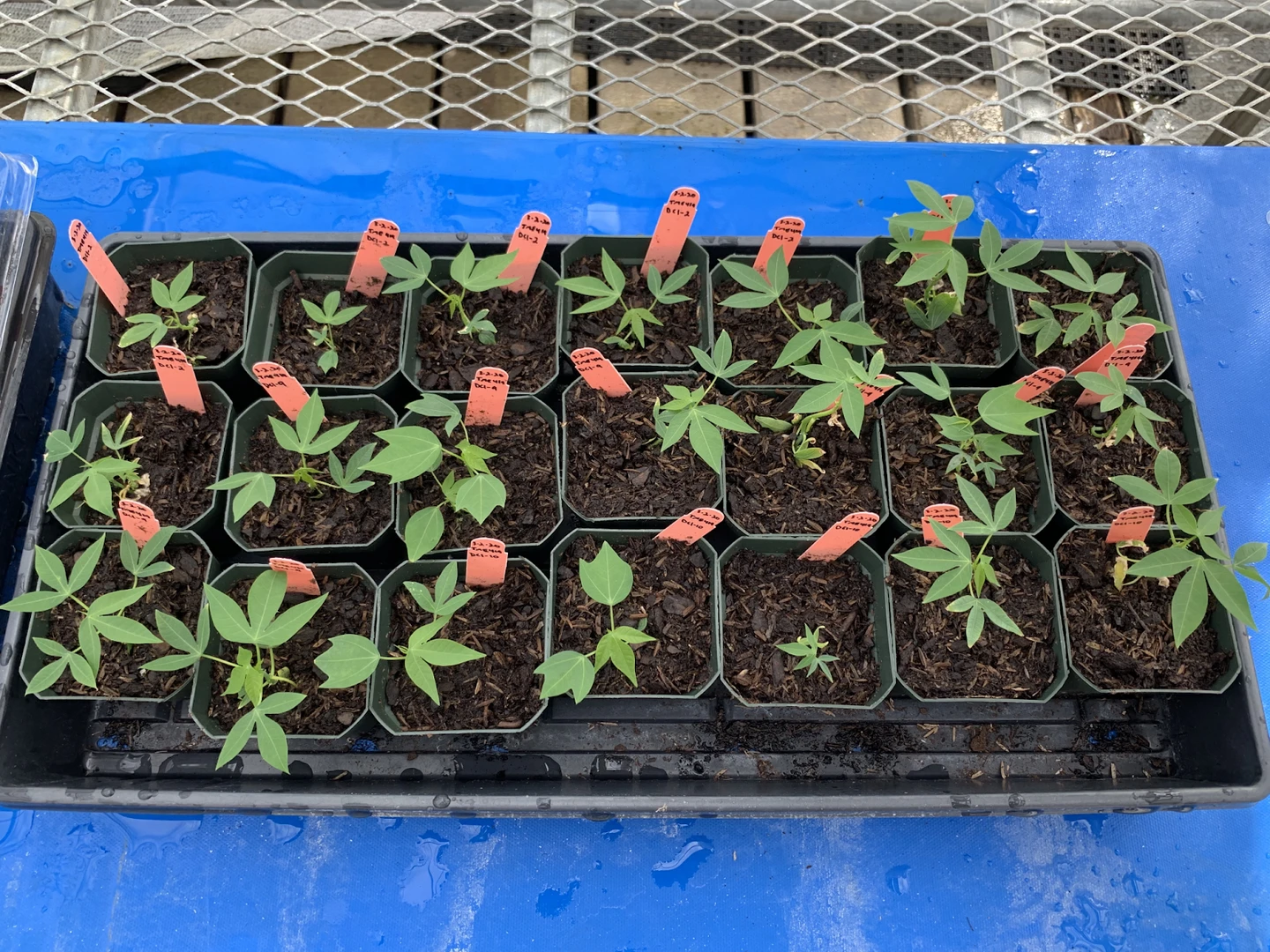
We can elute that back and get a measurement from a spectrophotometer. So we know that when we knock out both of the genes that code for this one enzyme at the beginning of the pathway, we don't detect cyanide in the tissue in the leaves or the roots. So that's one thing. The other thing is, of course, we're interested in doing field trials in Africa, in places where people eat the cassava and where it's the closest to a real farmer type situation.
Just expanding further down the road that there's a great variety of different cassava cultivars. It's important to maintain that diversity for disease resistance and also for cultural reasons. Right now we're working with a couple of cultivars of cassava that we feel would do quite well in the field, and down the road it would be great to expand to others to give them disease resistance or reduced cyanide content or other benefits.
Global Impact of CRISPR in Cassava Project
Cassava is a staple crop across the topics. In this section, we discuss the potential impact of this study in different countries and what the regulatory landscape might look like in different regions of the world.
The large cassava-cyanide impact in AfricaMinu: You mentioned that cassava is largely consumed across Africa. Was that one of the reasons that you chose this project or did that just happen to come along and you realize on the way that this disproportionately affects people in one continent?
Jessica: That's a good question. The effects of chronic consumption of cyanide are most well-documented in Africa. There aren't really cases that have been documented elsewhere. And I always say documented because diseases that affect people in the Global South may not be well-documented. But there's another thing at play here, which is that cassava was domesticated in Brazil and it was brought to Africa thousands of years later. And so even though cassava has been in Africa for hundreds of years, the processing methods in South America, where it's originally from, have been optimized over a much longer period of time. So that might have something to do with why these diseases, such as this paralytic disease konzo, are really only documented in Africa.
I would just add that, as I mentioned, I've been working on cassava from a genomics perspective since 2012, and I've had the pleasure of collaborating with African scientists. And I've also seen, through those collaborations, the importance of this crop and the importance of improving it more rapidly in the context of climate change and other pressures that people who eat cassava are under.
Minu: You mentioned that cassava is largely consumed across Africa. Was that one of the reasons that you chose this project or did that just happen to come along and you realize on the way that this disproportionately affects people in one continent?
Jessica: That's a good question. The effects of chronic consumption of cyanide are most well-documented in Africa. There aren't really cases that have been documented elsewhere. And I always say documented because diseases that affect people in the Global South may not be well-documented. But there's another thing at play here, which is that cassava was domesticated in Brazil and it was brought to Africa thousands of years later. And so even though cassava has been in Africa for hundreds of years, the processing methods in South America, where it's originally from, have been optimized over a much longer period of time. So that might have something to do with why these diseases, such as this paralytic disease konzo, are really only documented in Africa.
I would just add that, as I mentioned, I've been working on cassava from a genomics perspective since 2012, and I've had the pleasure of collaborating with African scientists. And I've also seen, through those collaborations, the importance of this crop and the importance of improving it more rapidly in the context of climate change and other pressures that people who eat cassava are under.
Regulatory landscape for CRISPR-edited cropsMinu: Since the documented aspects of cyanide poisoning are not as many in the US, do you foresee regulatory hurdles or just convincing people about why this is important in the first place?
Jessica: First, the reason that people aren't getting poisoned by chronic cyanide consumption in the US, is a few fold. It's really a disease of poverty for people who are relying on cassava predominantly, or maybe completely for calories. And then, as I mentioned, taking those shortcuts, or just not being able to process it completely.
So those of us in the US for example, there are plenty of protein sources. Protein helps your body detoxify the cyanide. We're probably not eating only cassava. So I'm confident that these diseases don't exist in the US.
When we're thinking about other countries, where we may want to introduce our new cassava varieties, we're thinking about regulatory hurdles and also the acceptance angle. That's just developing so rapidly we have to see how things work out.
Michael: The regulatory world is quite dynamic. When it comes to regulations for transgenic crops, that we would call GMOs (genetically engineered organisms, aka genetically engineered [GE]), that continues to be pretty firm throughout the world. However, small CRISPR edits that are akin to what is acquired through traditional breeding may not be regulated as GMOs. Countries like the United States, Colombia, Argentina, Australia, and Brazil, have adopted that regulatory approach. And recently I read an article showing that Nigeria has issued some gene editing guidelines that function similarly.
Jessica: The idea there is if it's a gene edited crop that has a transgenic cassette in it, as often they do, then it would be regulated as a GE crop. But if it doesn't have any transgenes, then it would not. And that's exciting. We at IGI are working on non-transgenic approaches to genome editing. For crops that they do crossing where there are isogenic lines or they are doing crossing, they can remove any transgenes through crossing, and then it wouldn't be regulated as a GE, but for cassava it's a little more complicated.
Cassava is typically vegetatively propagated. So people take a stem cutting, maybe a foot long or a couple of feet long, and you put it in the ground and then you'll get another cassava plant. The beauty of it is, if you have a cassava plant or just have a breed that you really like with the whole complement of traits you like, then when you propagate it this way, you'll get other cassava plants that have the same traits.
The drawbacks for that can be that we don't have inbred lines the way something like maize would. Cassava is highly heterozygous. And if you try to do conventional breeding with it, when you do a cross, the offspring are not going to have the same traits as the parents, because of the heterozygosity all the traits have been thrown up in the air and they don't land the same.
But what I wanted to get to is, that's why cassava is such a great candidate for genome editing because we can do the genome editing and because it's so precise, we're not disturbing other traits. So in our case, we're disturbing just this one pathway, but we can do it for the preferred varieties that people might like the way they taste or the texture or disease resistance, we can stack it with other traits.
Jessica: That is why we do need to get to the transgene free approaches, if regulation like this is a factor. But like Mike said, it's developing really fast. It depends on the country. People think of Europe as anti-GMO, but Europe is really not a monolith and in Africa everything's developing really quickly. Nigeria is at the forefront and we'll just have to see. Even in places that don't have the biosafety laws in place to allow release of genome edited crops, field trials are still possible. Maybe the proof is in the pudding.
Michael: And just to add toward that goal of non-transgenic crops: at the Innovative Genomics Institute with regards to cassava and other plants, they're exploring transient expression of the CRISPR system and also nano-particle delivery. That way we can deliver the CRISPR system in there, have the mutation that we're hoping for and no other footprint.
Minu: Since the documented aspects of cyanide poisoning are not as many in the US, do you foresee regulatory hurdles or just convincing people about why this is important in the first place?
Jessica: First, the reason that people aren't getting poisoned by chronic cyanide consumption in the US, is a few fold. It's really a disease of poverty for people who are relying on cassava predominantly, or maybe completely for calories. And then, as I mentioned, taking those shortcuts, or just not being able to process it completely.
So those of us in the US for example, there are plenty of protein sources. Protein helps your body detoxify the cyanide. We're probably not eating only cassava. So I'm confident that these diseases don't exist in the US.
When we're thinking about other countries, where we may want to introduce our new cassava varieties, we're thinking about regulatory hurdles and also the acceptance angle. That's just developing so rapidly we have to see how things work out.
Michael: The regulatory world is quite dynamic. When it comes to regulations for transgenic crops, that we would call GMOs (genetically engineered organisms, aka genetically engineered [GE]), that continues to be pretty firm throughout the world. However, small CRISPR edits that are akin to what is acquired through traditional breeding may not be regulated as GMOs. Countries like the United States, Colombia, Argentina, Australia, and Brazil, have adopted that regulatory approach. And recently I read an article showing that Nigeria has issued some gene editing guidelines that function similarly.
Jessica: The idea there is if it's a gene edited crop that has a transgenic cassette in it, as often they do, then it would be regulated as a GE crop. But if it doesn't have any transgenes, then it would not. And that's exciting. We at IGI are working on non-transgenic approaches to genome editing. For crops that they do crossing where there are isogenic lines or they are doing crossing, they can remove any transgenes through crossing, and then it wouldn't be regulated as a GE, but for cassava it's a little more complicated.
Cassava is typically vegetatively propagated. So people take a stem cutting, maybe a foot long or a couple of feet long, and you put it in the ground and then you'll get another cassava plant. The beauty of it is, if you have a cassava plant or just have a breed that you really like with the whole complement of traits you like, then when you propagate it this way, you'll get other cassava plants that have the same traits.
The drawbacks for that can be that we don't have inbred lines the way something like maize would. Cassava is highly heterozygous. And if you try to do conventional breeding with it, when you do a cross, the offspring are not going to have the same traits as the parents, because of the heterozygosity all the traits have been thrown up in the air and they don't land the same.
But what I wanted to get to is, that's why cassava is such a great candidate for genome editing because we can do the genome editing and because it's so precise, we're not disturbing other traits. So in our case, we're disturbing just this one pathway, but we can do it for the preferred varieties that people might like the way they taste or the texture or disease resistance, we can stack it with other traits.
Jessica: That is why we do need to get to the transgene free approaches, if regulation like this is a factor. But like Mike said, it's developing really fast. It depends on the country. People think of Europe as anti-GMO, but Europe is really not a monolith and in Africa everything's developing really quickly. Nigeria is at the forefront and we'll just have to see. Even in places that don't have the biosafety laws in place to allow release of genome edited crops, field trials are still possible. Maybe the proof is in the pudding.
Michael: And just to add toward that goal of non-transgenic crops: at the Innovative Genomics Institute with regards to cassava and other plants, they're exploring transient expression of the CRISPR system and also nano-particle delivery. That way we can deliver the CRISPR system in there, have the mutation that we're hoping for and no other footprint.
Experimental Challenges of CRISPR in Plants
Minu: What are the specific challenges of using CRISPR in plants?
Michael: So the challenge that we continue to improve upon is efficiency. Delivery into plant cells is harder than mammalian cells, because they're wrapped around by a cell wall, so we have to get creative. We can use Agrobacterium. This is a bacterium that's been a tool for a very long time that can deliver DNA. We've been using it to deliver the CRISPR system. The real challenge right now is improving upon the non-transgenic methods. There are a lot of tools, new publications coming out all the time of very creative ways to do so. And we're implementing them excitedly.
Jessica: I would just add to that the challenge for doing genome editing in plants isn't really specific to the genome editing. It's more specific to getting the embryonic tissue, having it be healthy and regenerating it back into whole plants. So these are technical challenges that are not specific to the CRISPR. CRISPR works great. You get the CRISPR in there, it tends to make edits, it tends to make them where we want. With minimal off-targets. But it's really just the artisanal approach you have to take to this very delicate tissue and culture. We're lucky we have a wonderful transformation facility at IGI and a great technician working on the project. And it just requires a lot of skill, patience, and labor for that part.
Michael: I'd like to touch on the impact that CRISPR has had on the agricultural space. It's made precision breeding in agriculture so much faster, easier and cheaper to do. Making targeted mutations is actually nothing new. For years, scientists have been using zinc finger nucleases and TALENs to make targeted mutations, but these protein complexes can be quite cumbersome to assemble. With CRISPR, the only thing that needs to be changed is 20 nucleotides of RNA. In addition, targeting multiple sites or multiplexing that requires just another guide RNA and not a whole other protein complex. So it's faster, easier, and cheaper.
Future of CRISPR in Crop Improvement
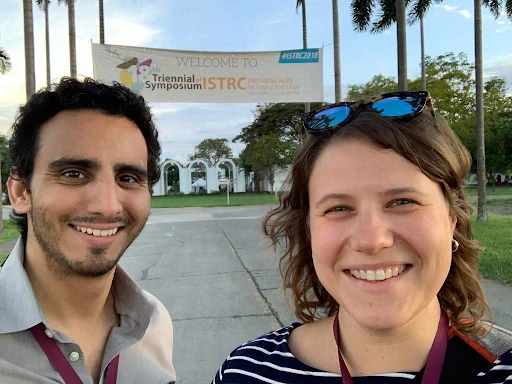
Cassava is a great example of how CRISPR is being used in plants, but it's not the only one. In this section, we learn more about other efforts around genome editing in crop improvement and discuss what the next few years will look like with the increasing adoption of CRISPR technology in this space.
CRISPR in other food safety projectsMinu: Are there more food safety projects being done in this space right now?
Michael: Speaking on food safety, there’s work to generate hypoallergenic plants. There was one collaboration between Spain and the US to generate low gluten wheat and another work out of the Hunan Agricultural University in China to reduce cadmium accumulation in rice. Cadmium being a highly toxic metal can cause cancer and other problems.
Expanding to other crop improvement projects: here at the IGI, we are working for disease resistance - for example, trying to generate disease resistant cocoa. In another lab, Ksenia Krasileva and her team are working to create novel plant immune receptors for disease resistance. Another big direction for the Innovative Genomics Institute is climate change resilience and climate change mitigating crops. So for example, Richard Dodd is examining the role of particular sugar pine tree genes in drought and temperature stress. So there's a lot of potential that CRISPR has here.
Just to expand a little further with this effort to reduce the cyanide in cassava. It's not only about health impacts. There could also be environmental impacts in the processing of cassava at the industrial level. Some of this cyanide can escape into the wastewater and impact the local animal life, plant life. And, looking at it from an economic perspective, you can reduce the cost of processing cassava at all levels, that could really be a boon to everyone involved.
Minu: Are there more food safety projects being done in this space right now?
Michael: Speaking on food safety, there’s work to generate hypoallergenic plants. There was one collaboration between Spain and the US to generate low gluten wheat and another work out of the Hunan Agricultural University in China to reduce cadmium accumulation in rice. Cadmium being a highly toxic metal can cause cancer and other problems.
Expanding to other crop improvement projects: here at the IGI, we are working for disease resistance - for example, trying to generate disease resistant cocoa. In another lab, Ksenia Krasileva and her team are working to create novel plant immune receptors for disease resistance. Another big direction for the Innovative Genomics Institute is climate change resilience and climate change mitigating crops. So for example, Richard Dodd is examining the role of particular sugar pine tree genes in drought and temperature stress. So there's a lot of potential that CRISPR has here.
Just to expand a little further with this effort to reduce the cyanide in cassava. It's not only about health impacts. There could also be environmental impacts in the processing of cassava at the industrial level. Some of this cyanide can escape into the wastewater and impact the local animal life, plant life. And, looking at it from an economic perspective, you can reduce the cost of processing cassava at all levels, that could really be a boon to everyone involved.
Predicting 5-year progress with CRISPRMinu: The space is just exploding right now with tons of opportunity for using CRISPR and gene editing in general for all these improvements. Say five years down the line, where do you see the future of agriculture with all these explosive opportunities?
Michael: A technical advancement that a lot of scientists would like is the improvement of precise editing. So for example, Homology Directed Repair (HDR). At this time, it's pretty straightforward and easy to make a mutation where you want it, but you don't have much governance for what that mutation is going to be. And so with new tools such as CRISPR prime editing and HDR, if we can improve upon that, that would be awesome.
Jessica: For our project, five years down the line, I would love to say that we have results of field trials. That's what I really want to see. Also to have the non-transgenic plants; I think they will be a little bit more versatile for release. As far as the field goes, it's really exciting. Especially in the context of climate change, we really need to be releasing new varieties of plants that are better adapted to this changing climate and all the things that come with it. For example, in cassava, climate change is causing increased drought. Drought causes higher levels of the cyanide in the plants.
That's just one example. All of us doing plant breeding need to respond quickly. So I would love to see even in five years that there's also these pipelines in place that we're releasing these new varieties more quickly so that we can really respond to climate change.
Minu: The space is just exploding right now with tons of opportunity for using CRISPR and gene editing in general for all these improvements. Say five years down the line, where do you see the future of agriculture with all these explosive opportunities?
Michael: A technical advancement that a lot of scientists would like is the improvement of precise editing. So for example, Homology Directed Repair (HDR). At this time, it's pretty straightforward and easy to make a mutation where you want it, but you don't have much governance for what that mutation is going to be. And so with new tools such as CRISPR prime editing and HDR, if we can improve upon that, that would be awesome.
Jessica: For our project, five years down the line, I would love to say that we have results of field trials. That's what I really want to see. Also to have the non-transgenic plants; I think they will be a little bit more versatile for release. As far as the field goes, it's really exciting. Especially in the context of climate change, we really need to be releasing new varieties of plants that are better adapted to this changing climate and all the things that come with it. For example, in cassava, climate change is causing increased drought. Drought causes higher levels of the cyanide in the plants.
That's just one example. All of us doing plant breeding need to respond quickly. So I would love to see even in five years that there's also these pipelines in place that we're releasing these new varieties more quickly so that we can really respond to climate change.

